
Soapmaking is a fun and creative hobby and starting a soapmaking business can be a rewarding and profitable venture. In this blog post, we’ll guide you through the essential steps to start a successful soapmaking business.
Why Start A Soapmaking Business
Starting a soapmaking business can offer you both personal and financial benefits. Personally, it is a creative outlet in that it allows you to develop your own fragrance blends, designs, shapes, etc., and you can customize soaps based on the needs of your customers. Financially, it can bring in an income on the side of a regular day job or become a full-time entrepreneur and work for yourself. You can create your own brand, set your own schedule, and make your own decisions.
Many people are moving towards natural handmade soap and away from commercial soaps containing harsh chemicals and artificial additives. These chemicals can strip the skin of its natural oils. Natural ingredients in handmade soap provide benefits to the skin such as moisture retention, gentle exfoliation, and skin nourishment.
Globally, there has been an increase in the practice and awareness of proper hygiene and handwashing. Soap has become an ever more important part of our daily routine.
Like any other skill, soapmaking can be acquired through practice and persistence. By remaining patient and determined, you can create exquisite, nourishing, and luxurious soaps that will captivate your customers’ hearts.
Since soap is a consumable item, your customers will have a continual need to restock the supply of their preferred blends and fragrances.
Planning for Your Soapmaking Business
Learning to Make Handmade Soap
First of all, you have to know how to make soap. If you are already versed in the art of soapmaking you can skip this section.
But if you have never made a bar of soap in your life, you can start learning today!
You can choose to attend workshops in your local area or learn soapmaking yourself by reading books and watching tutorials online. There are lots of resources online that can be used to learn – both paid and free, giving you the flexibility to choose according to your preferences.
Furthermore, some of the equipment that you will need to whip together your first batch of soap may already be in your kitchen.
If you would like to see one of my most popular soap recipes and the process of making it, here is the link to my Turmeric and Ginger Soap.
Soapmaking for Beginners
If you would like to get started making natural soaps, I recommend Natural Soap Making by Jan Berry of the Nerdy Farmwife.
In her soapmaking program you will learn:
• cold process soap basics
• adding herbs & flowers to soap
• colouring soap naturally
• how to use a lye calculator
• Plus 35 palm-free soap recipes!
Click here to learn more
Test Your Handmade Soap and Perfect Your Recipe
Once you have learned the basics of soapmaking, spend time working on perfecting your product.
Try different recipes, presentations, fragrances, additives etc., to get the perfect combination and right balance of lather, moisturization, hardness, cleansing and fragrance.
It’s essential to familiarize yourself with the various properties of oils used to make soap. You should also gain knowledge on fragrances and essential oils and their impact on the soapmaking process.
For instance, certain fragrances, like vanilla, can alter the trace in cold process soap, which could affect your ability to execute intricate swirls and designs. By understanding these factors, you can optimize your soapmaking skills and create stunning soap designs.
When making cold process soap, it is important to note that it will need to cure for a period of 4 to 6 weeks before it can be used and tested for quality. To determine which recipes work best for your soap-making objectives, start with small batches and keep detailed records of the ingredients used and dates of production. Once the soap has cured, you can test out its various qualities and take notes to evaluate its effectiveness.
Share free samples with family and friends to get feedback as well.
- Related Post: How to Make Soap from Scratch – For Beginners
- Related Post: Tools Needed to Make Soaps at Home
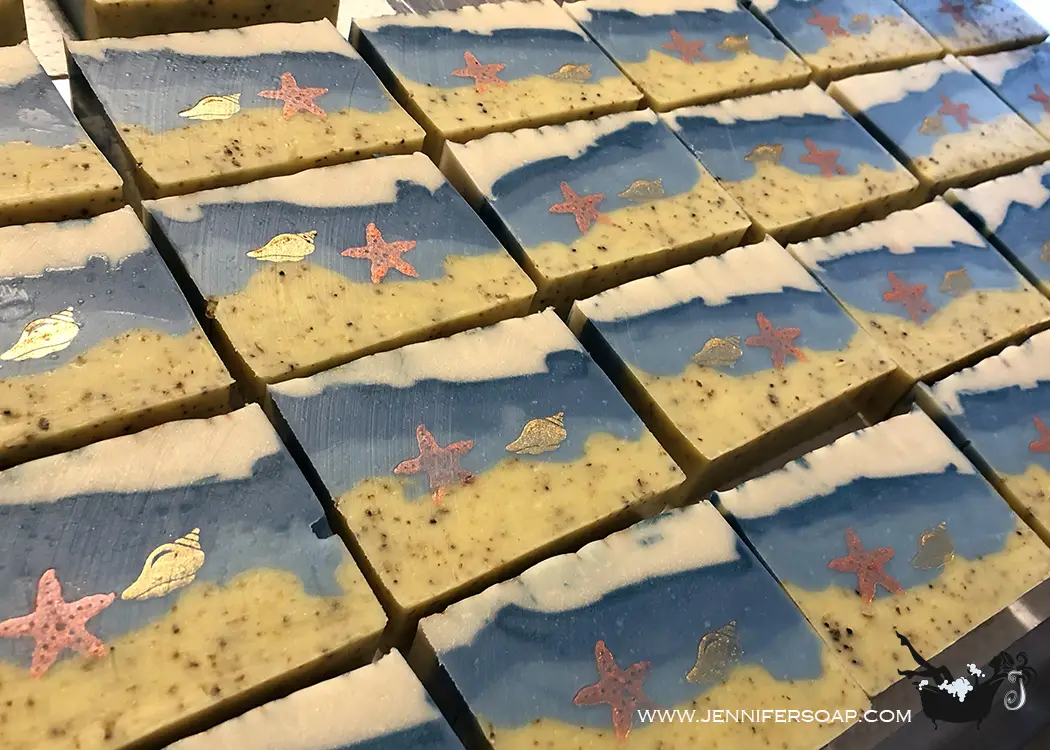
Photo courtesy Jennifer Hoffman of Jennifer Soap.
Read Jennifer’s unique story here, about how she got started and now runs a successful soapmaking business from her home.
What Type of Soap Will You make?
There are different ways to produce a bar of soap.
It’s up to you to determine which of these processes you’d like to incorporate into your business or if you prefer to utilize all of them based on your product goals. Keep in mind that each process has its own advantages and disadvantages to consider.
Anne-Marie Faiola, CEO and founder of Bramble Berry on her blog The Soap Queen, has a great article detailing the pros and cons of each. Read the article here.
Setting Up a Soapmaking Operation at Home
Before setting up your soapmaking operation at home, it’s important to decide where you will be mixing your soap recipes, storing them during the curing process, and setting up your office space. Your office space can be as simple as a desk or dining table, depending on your available space.
When it comes to soap production, your kitchen can serve as a suitable workspace, provided you have a few basic tools. Additionally, you will need sufficient shelving to store your soaps, allowing proper airflow for curing and drying.
For a list of supplies you may need to get started, see my post on Tools Required for Making Soap At Home.
Inventory storage
When it comes to making soap, having a designated storage area for your supplies is crucial. Ideally, this space should be located away from areas where children and pets can access it. The reason for this is simple: many of the ingredients used in soapmaking can be harmful if ingested or come into contact with the skin in an undiluted form.
When choosing a storage area, consider factors such as temperature, humidity, and ventilation. Soapmaking ingredients are best stored in a cool, dry place with good ventilation to prevent moisture buildup and prevent the growth of bacteria or mould.
Additionally, it’s important to keep your supplies organized and labelled properly, so you can easily find what you need when it’s time to make soap.
Some soapers prefer to use dedicated cabinets or shelves to store their supplies, while others may opt for storage containers or bins. Whatever storage method you choose, make sure that it’s secure and that the containers are properly sealed to prevent spills or leaks. If you have pets, consider using storage containers with secure lids to prevent them from accessing your supplies.
We also want to keep insects like ants and weevils from getting into natural herbs and additives so ensure these are in sealed containers as well.
Finally, it’s important to periodically review your inventory to make sure that your supplies are still fresh and in good condition. Many soapmaking ingredients have a limited shelf life, so it’s important to use them before they expire to ensure that your soap is of the highest quality possible. By taking the time to properly store and organize your supplies, you can ensure that you have everything you need to make beautiful, high-quality soap.
Research and Brainstorm for your Soapmaking Business
Decide on your niche market
To establish your business, it’s important to identify your niche market. This involves deciding on the type of soap you will specialize in, determining your target audience, and considering whether you will sell your products wholesale, retail, or both.
It’s important to have both short-term and long-term plans for your business. Short-term plans may include identifying suppliers, creating a product line, and establishing a sales channel. Long-term plans may involve expanding your product line, exploring new markets, and building relationships with larger businesses in the hospitality industry like hotels, guest houses, or resorts.
When identifying your niche market, consider what type of soap you would like to create. This could include bar soap, liquid soap, or speciality soap such as herbal, natural, organic, vegan or allergy-friendly options.
You could incorporate a theme into your soap line, such as using tropical or Caribbean-inspired ingredients to create unique and exotic scents. You might also consider developing soaps with additional niche focuses, such as therapeutic properties, unique textures, or aesthetic designs.
You can differentiate yourself from other soapmakers and appeal to a specific target market. This will help you establish a brand identity and build a loyal customer base over time.
Wholesale or Retail
Selling wholesale or providing private label options for your business can be an effective way to reach a different market segment.
By targeting businesses in the hospitality industry, you can potentially secure large orders and establish a regular client base. Providing private label options can also help establish your brand as a high-quality supplier of custom-made soaps.
Retail sales, on the other hand, may allow you to reach a wider audience and provide greater exposure for your business. Retail sales can be achieved through various channels, such as an online store, craft markets, or pop-up shops.
By offering both wholesale and retail options, you can diversify your sales channels and potentially increase your revenue streams.
As your business expands, you’ll have the opportunity to gather valuable feedback from your customers. Then you can identify which products are the most popular and make strategic decisions about how to specialize or refine your products to better meet the needs and preferences of your target market.
Suppliers and supplies
Study the types of hardware and supplies you’ll need to purchase. While some items, such as stainless steel bowls, plastic jugs, and silicone moulds, can be reused with each new batch of soap, others will need to be regularly replenished. These include oils, fragrances, lye, glycerin base, butters, micas, oxides, and other ingredients that go into making soap.
To avoid wasting money on unnecessary purchases, it’s a good idea to start with smaller quantities of these ingredients and test out various recipes to determine which ones yield the highest quality product.
For example, you may discover that you don’t like using palm oil in your soap and don’t want to be stuck with a large bucket of it that you won’t use. By taking a measured approach to purchasing supplies and ingredients, you can minimize waste and keep your costs under control as you grow your business.
When you have found the recipes you will use, find suppliers that sell in bulk to purchase your ingredients at wholesale prices or at a discount.
A note about purchasing from overseas or distant suppliers: Always check with your shipping company before purchasing sodium or potassium hydroxide as well as some essential oils as these may be considered hazardous materials when shipped via air.
By taking a proactive approach to shipping hazardous materials, you can avoid potential complications and delays and ensure that your business runs smoothly.
Packaging materials
When it comes to packaging your soap products, the possibilities are endless. You can get creative and use a variety of materials, from simple brown paper and twine to organza bags, fabric, or even your own custom-made packaging. Additionally, there are many sustainable and eco-friendly options available to help minimize your environmental footprint.
Most soapmaking suppliers carry a range of packaging options to choose from. By choosing packaging that is both beautiful and environmentally friendly, you can enhance your customer experience and build a loyal following.
Will You Need Support?
Will you require additional support such as an accountant or an assistant? Can you be a one-woman (or man) operation?
Depending on the scale of your operation, you may be able to handle everything on your own, or you may need assistance in certain areas. It’s a good idea to assess your strengths and weaknesses, as well as your available resources, to determine where you may require additional help.
If you do find that you need assistance with certain aspects of the business, there are many options available, including seeking guidance from a mentor or bartering services with others who have the skills you need.
For example, you could offer to babysit a few times for a business-savvy friend in exchange for some basic accounting instruction. By being resourceful and open-minded, you can build a support network to help you succeed in your soapmaking business without breaking the bank.
Promotion Strategies
Despite the rise of digital marketing, distributing physical promotional materials such as flyers, business cards, and brochures is still a viable method of promotion for your business. These materials can be easily created using online design tools like Canva or PicMonkey and can be distributed to potential customers to generate interest and increase brand awareness.
You can also offer samples of your soaps to potential customers as a way to generate positive word-of-mouth and build a loyal customer base.
In addition to physical promotions, you can also leverage online platforms to promote your soap products. Even if you don’t have an e-commerce store or website, you can use social media platforms like Facebook and Instagram to showcase your products and connect with potential customers.
Pinterest is another valuable resource to get your products seen and generate interest in your products. By taking advantage of both physical and digital marketing strategies, you can grow your business and reach a wider audience.
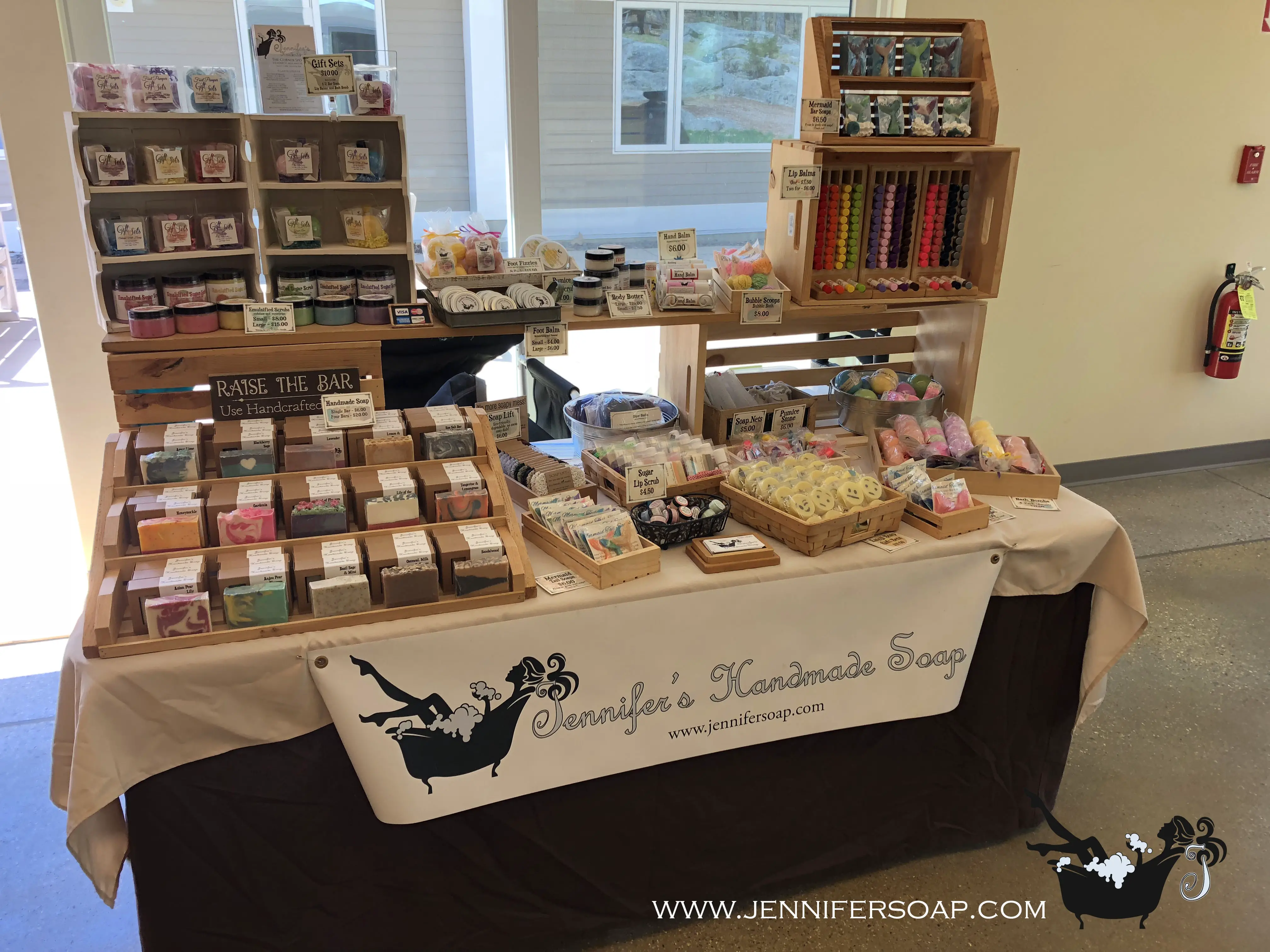
Photo courtesy Jennifer Hoffman of Jennifer Soap.
- Related Post: How to Develop an Entrepreneurial Mindset
- Related Post: The Entrepreneur’s Startup Gameplan
Choose and Register your Business Name
When selecting a business name, it’s important to choose one that accurately reflects your brand and allows for potential expansion into other product lines, such as scented candles, bath bombs, handmade lotions and creams, and lip balms.
Choose a name that is memorable, distinctive, and aligned with your overall vision for your business. Registering your chosen name will help ensure that it is legally protected and cannot be used by others in the industry.
Also, conduct thorough research to ensure that the name is not already in use by another company or trademarked. This involves checking the availability of the domain name for your business website as well as the business name on social media platforms.
You can search your local registrar’s database online or visit their office in person to start the process of registering your business name, depending on the requirements in your area. It is also wise to have alternative name options in case your first choice is unavailable or already taken.
Get Licenses and Permits
Make sure to research and understand the licensing and permit requirements for starting a soapmaking business in your local area. This includes obtaining any necessary licenses, permits, and insurance.
Additionally, be aware of labelling requirements such as the need to list all ingredients and weights.
It may be helpful to look into insurance programs such as the one offered by the Handcrafted Soap and Cosmetic Guild for those in the United States, Puerto Rico, and Canada.
I recommend reading Soap & Cosmetic Labeling: How to Follow the Rules and Regs Explained in Plain English by Marie Gale.

 Get a logo
Get a logo
If you have no design skills, a logo can be made inexpensively, on Fiverr by one of their creatives. Just go to Fiverr.com, under Graphics and Design and search for a graphic designer that you want to work with. Be sure to check out their portfolio and ratings to choose someone who is reputable.
Create a Business Plan
Once you have brainstormed and organized your ideas, it’s time to create a business plan for your soapmaking business. It doesn’t have to be extensive or complicated unless you want it to be. The Balance Small Business offers a simple business plan template that can help you get started with the planning process.
Plan Your Finances
To determine the selling price of your soap, you need to calculate the total cost per product, which includes expenses like raw materials, equipment, labour costs, internet, and electricity. Only after considering all these costs can you determine the profit margin for your soapmaking business.
Here are two resources from Soap Queen to give you guidance:
Software/Apps
SoapCalc recipe calculator is an online tool available for free, designed to help you calculate the correct ratios of ingredients needed for your soap recipe. It can also provide an estimate of the soap’s quality based on the oils used in the recipe.
The Soapmaker 3 software is a wonderful product to invest in if you want software that will help you to keep your soapmaking business records in order and help with accounting as well as recipe calculations.
These are some of the features of the Professional Soapmaker 3 program:
- Built-in recipe calculation – the ratio of lye to water, fragrances etc.
- Graphical display of soap qualities
- Recipe costs are calculated based on ingredient costs
- Save the names and contact information of suppliers
- Inventory Management
- Customer Listings
- Customer Invoicing
- free Upgrades to the Program
Craftybase is a comprehensive inventory management and cost tracking tool that can be a game-changer for soapmakers who want to take their business to the next level. With a wide range of features and tools, Craftybase makes it easy to manage inventory, track costs, and make data-driven decisions to grow your soapmaking business.
Here are some of the key reasons why Craftybase is good for your soapmaking business:
- Accurate inventory management: With Craftybase, you can easily track your inventory levels in real-time. This means you’ll always know what materials you have on hand and when you need to reorder. This can help you avoid stockouts and keep your production running smoothly.
- Cost tracking: One of the biggest challenges for soapmakers is tracking the cost of materials and ingredients. With Craftybase, you can easily track the cost of all your materials, including fragrances, oils, and other ingredients. This makes it easy to calculate the true cost of each batch of soap you make, which can help you price your products more effectively.
- Recipe management: Craftybase allows you to create and save recipes for all your soap products. This means you can easily see the cost and inventory requirements for each batch of soap you make, and make adjustments as needed. This can help you optimize your production process and reduce waste.
- Sales tracking: Craftybase allows you to track your sales data and analyze your business performance. You can see which products are selling well, which ones aren’t, and adjust your production accordingly. This can help you make data-driven decisions to grow your business.
- Integration with e-commerce platforms: If you sell your soap online, Craftybase integrates with popular e-commerce platforms like Etsy and Shopify. This means you can easily import your sales data and keep track of your inventory levels across multiple sales channels.
Overall, Craftybase is a powerful tool for soapmakers who want to streamline their inventory management, track their costs, and make data-driven decisions to grow their business.
GET STARTED

Photo courtesy Jennifer Hoffman of Jennifer Soap.
Set Up Your Soapmaking Business Workshop/Studio in Your Home
It’s essential to have a dedicated space to work on your craft. Before setting up your workspace, there are a few things to think about:
- Location: Choose a space that is well-ventilated and quiet.
- Equipment and storage: You will need adequate space to store all of your soapmaking equipment and raw materials.
- Proper Lighting: Adequate lighting is necessary to ensure that you can see what you are doing.
- Safety: When working with chemicals, it’s crucial to prioritize safety. Keep a first aid kit on hand and have a fire extinguisher nearby. Ensure that your workspace is free from any tripping hazards and that all electrical equipment is in good working order.
Purchase Inventory
After conducting research on supplies and suppliers, you should have a list of sources for the raw materials needed to make your soap. You can now begin to purchase your inventory from these sources.
Again, it’s a good idea to start small and purchase smaller quantities of the necessary ingredients until you’ve perfected your recipe.
In addition to the raw materials, you’ll also need to purchase any necessary equipment and packaging materials. Be sure to factor these costs into your budget when making your inventory purchases.
Start manufacturing
The exciting part begins now as you embark on the soap manufacturing process.
As you create your soaps, make sure to keep detailed records such as the recipe, date of production, expected cure date, and associated production costs.
Promotion
After you have manufactured your soap bars, it is time to showcase them to the world.
Take high-quality photographs of your products from different angles and settings. You can use a professional camera or even a smartphone with a good camera to take pictures. These photos can be used to create promotional materials like flyers, brochures, business cards, and even post them to your website or social media platforms.
In today’s digital age, social media platforms are powerful marketing tools. Platforms like Facebook, Instagram, and Twitter can help you showcase your products to a large audience. Pinterest is also an excellent platform to promote your business.
Resources
To get you started with your soapmaking journey, here is a list of resources.
Handcrafted Soap and Cosmetic Guild (HSCG)
Soapmaking Bloggers to Follow
https://www.modernsoapmaking.com/
https://jennifersoap.wordpress.com
Books to Learn Soapmaking
Soap Making Made Easy (Free ebook)
Natural Soapmaking Ebook Collection


Scientific Soapmaking: The Chemistry of the Cold Process




Pure Soapmaking: How to Create Nourishing, Natural Skin Care Soaps




Making Soap From Scratch: How to Make Handmade Soap – A Beginners Guide and Beyond


Soap Crafting: Step-by-Step Techniques for Making 31 Unique Cold-Process Soaps

Soap Making Business Books
Good Manufacturing Practices for Soap and Cosmetic Handcrafters
Soap and Cosmetic Labeling: How to Follow the Rules and Regs Explained in Plain English
Soap Making Business Startup: How to Start, Run & Grow a Million Dollar Success From Home!
YouTube Channels
Soap Making Courses/Workshops
Online – Soapmaking Success Course
Online – https://www.udemy.com/how-to-make-soap/
Online – https://www.universalclass.com/i/course/soap-making-101.htm
Trinidad and Tobago and Barbados- https://www.scentsoftobago.com/
Bahamas – Bahamas Candle and Soap
Alberta, Canada – https://www.soapandmore.com/workshops-2018.html
Huddersfield, UK – https://soapschool.com/
Sydney, Austrailia – http://www.sydneysoapmaking.com/
Bangalore, India – https://www.facebook.com/soapsmith.soapmaking/
Suppliers
Longzang Company (detailed silicone soap molds)
Van Yulay (silicone molds and molds for embeds)
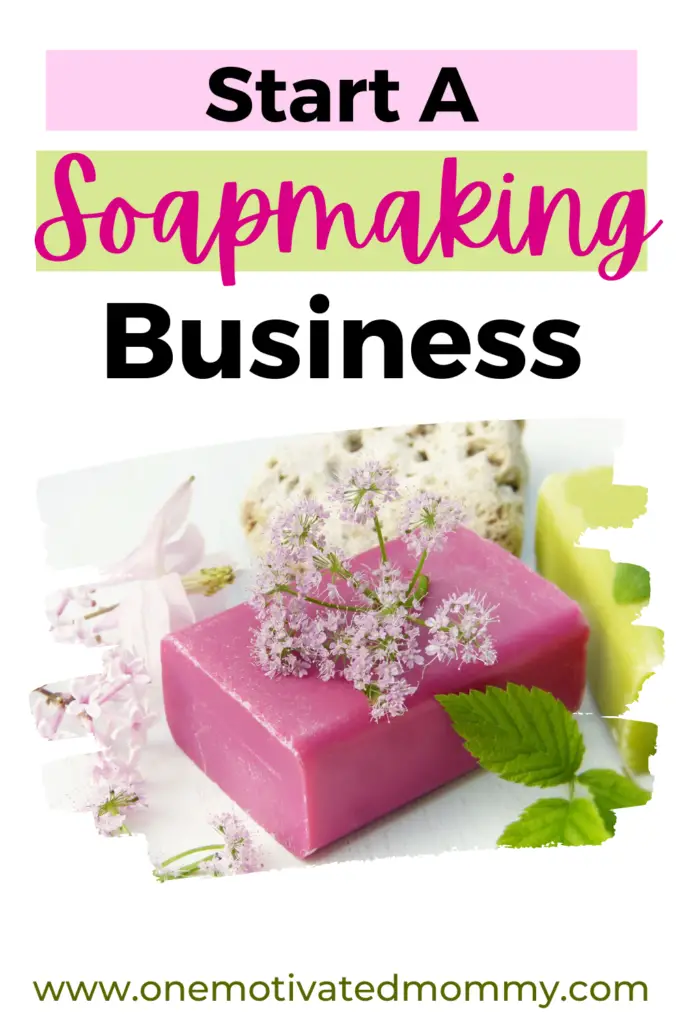

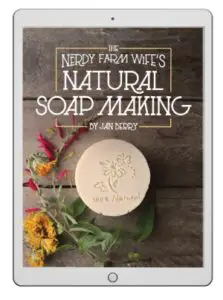
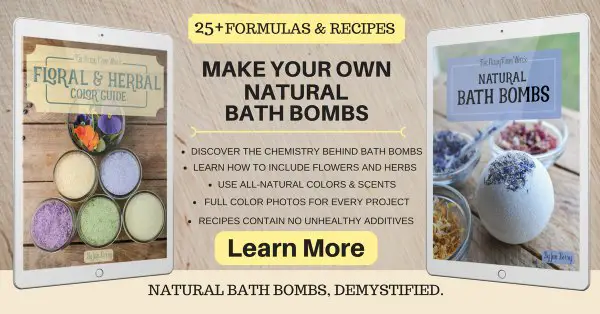





This is very nice post and useful too. -P.C.Sarcar-
Thank you. I am happy to hear that, P.C. Sarcar. Hoping to bring more information like this in the near future.
It was going great until the mention of Fiverr. This page doesn’t guarantee original work, I have seen stories of plagarized logos and designs plus that’s what real graphic designers are for! A graphic designer doesn’t have to be expensive!
And thank you for sharing this, I’m doing research on soap making!
Leen, you’re welcome.
I understand what you are saying and that is why I always recommend my readers check the portfolio and reviews before deciding on someone to design a logo. Thanks for your comment.
Great information for beginners like me! Thank you!
You’re welcome, Barb. Best wishes to you.
Thank you so much for the information! I LOVE soap making, highly addictive…
How do I find hotels or potential buyers. Etc. That would or could be interested my product? Is this local hotel/motels businesses only?
Hi, Dan. Yes, it is indeed very addictive!
For starters, you could target smaller hotels or guest houses, bed and breakfasts, spas and gift-shops in your local area to get a customer or two under your belt to build your portfolio so-to-speak.
Have a target market in mind and tailor your product for that market. For example, here in the Caribbean, tourists may want to try fragrances and additives that are native to our tropical islands, like hibiscus, guava, moringa, passionfruit, soursop etc. The possibilities are endless when it comes to developing a unique product.
Next, give out samples of your soaps to receive feedback from friends, family and/or acquaintances who may be working in the hospitality industry.
Tweak and perfect your most outstanding products, packaging, branding and work out your wholesale prices.
Some market research into prices and quality of products offered by competitors in the field will help you to give good value to your customer both in product and price.
Also look into the core values of the potential customer. They may be a vegan or environmentally conscious business and therefore you can offer products with biodegradable packaging and vegan ingredients.
When you are ready to promote your soap to the hotel, BnB, spa etc., contact the Director of Purchasing and send them a sample of your soap as well as a letter outlining the specifics of your product and what makes your soap the best choice for their guests/customers.
Best wishes to you, Dan and happy soaping!